Analyzing Tata Group's Growth Strategies: A Detailed Report
VerifiedAdded on 2020/03/04
|13
|3344
|149
Report
AI Summary
This report provides a detailed analysis of the Tata Group's growth strategies, encompassing both organic and inorganic approaches. It explores the company's portfolio organization, integrated organization perspective, and competitive strategies, including technological innovations through strategic alliances and mergers and acquisitions (M&As). The report examines the impact of these strategies on the business model, including the adoption of technologies like Microsoft SharePoint and the development of products like PraveshDoors. Furthermore, the report delves into the leadership skills that fostered the firm's use of Corporate Social Responsibility (CSR), highlighting initiatives like the Lifeline Express and various community-focused programs. The analysis also considers the challenges faced by the company, such as fluctuating costs and market dynamics, and offers insights into the company's approach to governance and corporate responsibility.
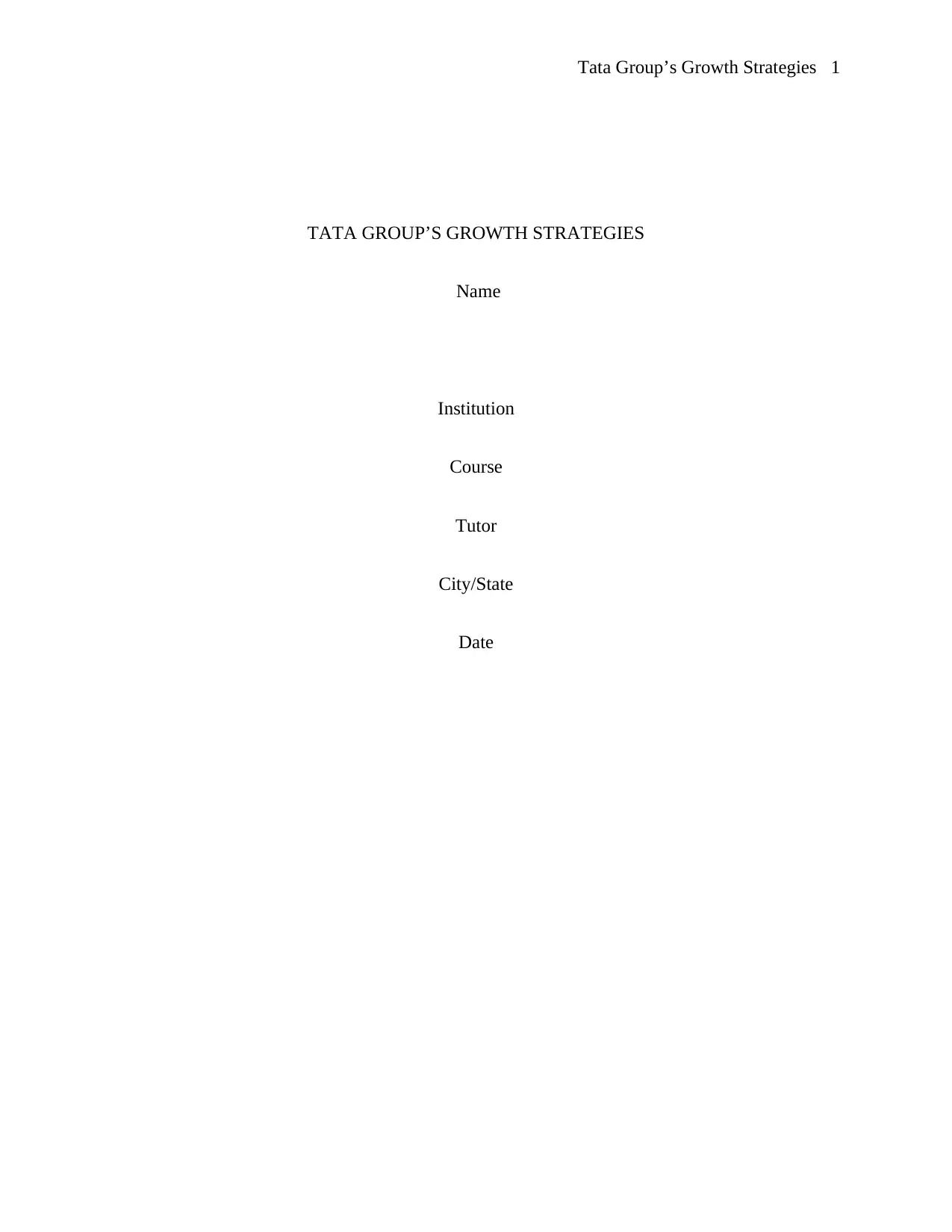
Tata Group’s Growth Strategies 1
TATA GROUP’S GROWTH STRATEGIES
Name
Institution
Course
Tutor
City/State
Date
TATA GROUP’S GROWTH STRATEGIES
Name
Institution
Course
Tutor
City/State
Date
Paraphrase This Document
Need a fresh take? Get an instant paraphrase of this document with our AI Paraphraser
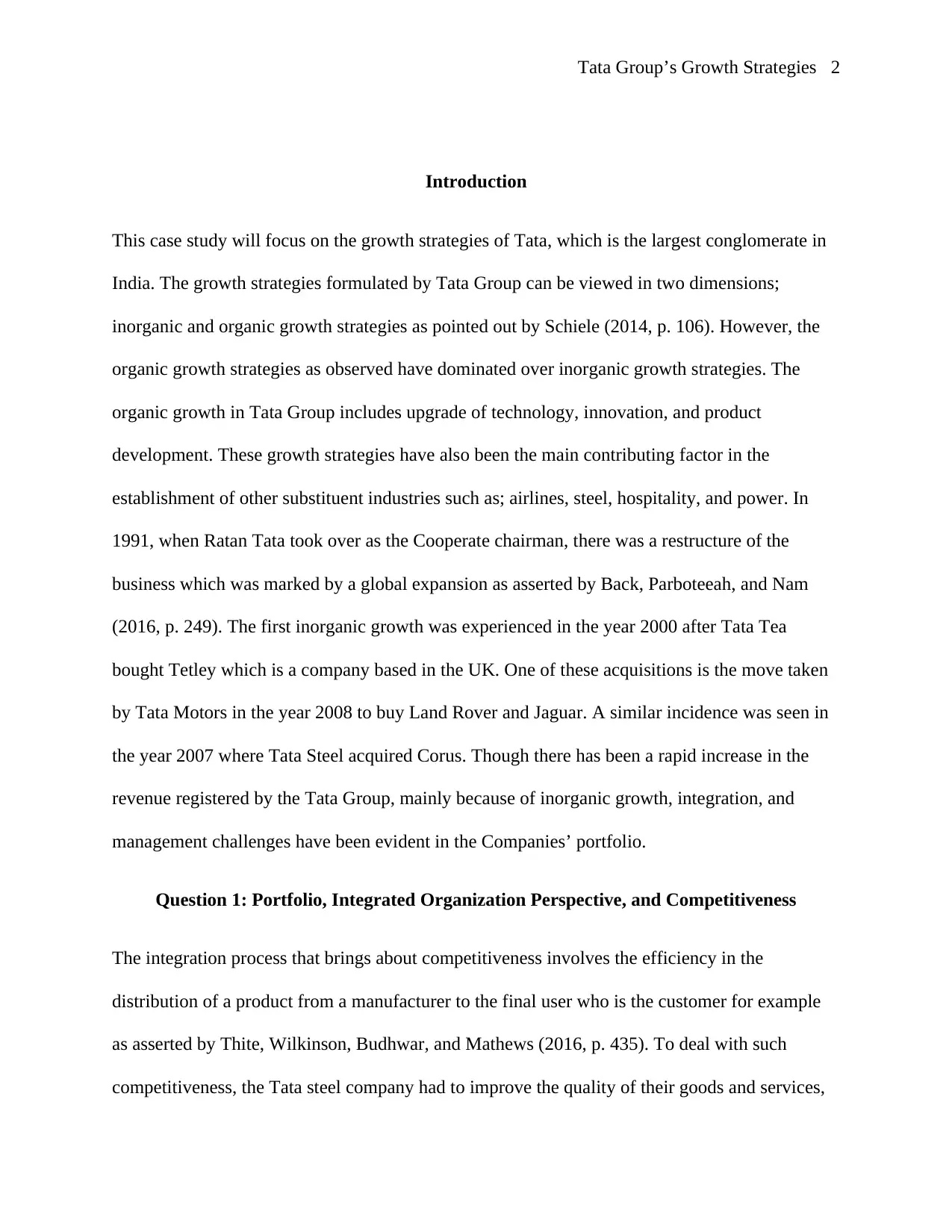
Tata Group’s Growth Strategies 2
Introduction
This case study will focus on the growth strategies of Tata, which is the largest conglomerate in
India. The growth strategies formulated by Tata Group can be viewed in two dimensions;
inorganic and organic growth strategies as pointed out by Schiele (2014, p. 106). However, the
organic growth strategies as observed have dominated over inorganic growth strategies. The
organic growth in Tata Group includes upgrade of technology, innovation, and product
development. These growth strategies have also been the main contributing factor in the
establishment of other substituent industries such as; airlines, steel, hospitality, and power. In
1991, when Ratan Tata took over as the Cooperate chairman, there was a restructure of the
business which was marked by a global expansion as asserted by Back, Parboteeah, and Nam
(2016, p. 249). The first inorganic growth was experienced in the year 2000 after Tata Tea
bought Tetley which is a company based in the UK. One of these acquisitions is the move taken
by Tata Motors in the year 2008 to buy Land Rover and Jaguar. A similar incidence was seen in
the year 2007 where Tata Steel acquired Corus. Though there has been a rapid increase in the
revenue registered by the Tata Group, mainly because of inorganic growth, integration, and
management challenges have been evident in the Companies’ portfolio.
Question 1: Portfolio, Integrated Organization Perspective, and Competitiveness
The integration process that brings about competitiveness involves the efficiency in the
distribution of a product from a manufacturer to the final user who is the customer for example
as asserted by Thite, Wilkinson, Budhwar, and Mathews (2016, p. 435). To deal with such
competitiveness, the Tata steel company had to improve the quality of their goods and services,
Introduction
This case study will focus on the growth strategies of Tata, which is the largest conglomerate in
India. The growth strategies formulated by Tata Group can be viewed in two dimensions;
inorganic and organic growth strategies as pointed out by Schiele (2014, p. 106). However, the
organic growth strategies as observed have dominated over inorganic growth strategies. The
organic growth in Tata Group includes upgrade of technology, innovation, and product
development. These growth strategies have also been the main contributing factor in the
establishment of other substituent industries such as; airlines, steel, hospitality, and power. In
1991, when Ratan Tata took over as the Cooperate chairman, there was a restructure of the
business which was marked by a global expansion as asserted by Back, Parboteeah, and Nam
(2016, p. 249). The first inorganic growth was experienced in the year 2000 after Tata Tea
bought Tetley which is a company based in the UK. One of these acquisitions is the move taken
by Tata Motors in the year 2008 to buy Land Rover and Jaguar. A similar incidence was seen in
the year 2007 where Tata Steel acquired Corus. Though there has been a rapid increase in the
revenue registered by the Tata Group, mainly because of inorganic growth, integration, and
management challenges have been evident in the Companies’ portfolio.
Question 1: Portfolio, Integrated Organization Perspective, and Competitiveness
The integration process that brings about competitiveness involves the efficiency in the
distribution of a product from a manufacturer to the final user who is the customer for example
as asserted by Thite, Wilkinson, Budhwar, and Mathews (2016, p. 435). To deal with such
competitiveness, the Tata steel company had to improve the quality of their goods and services,
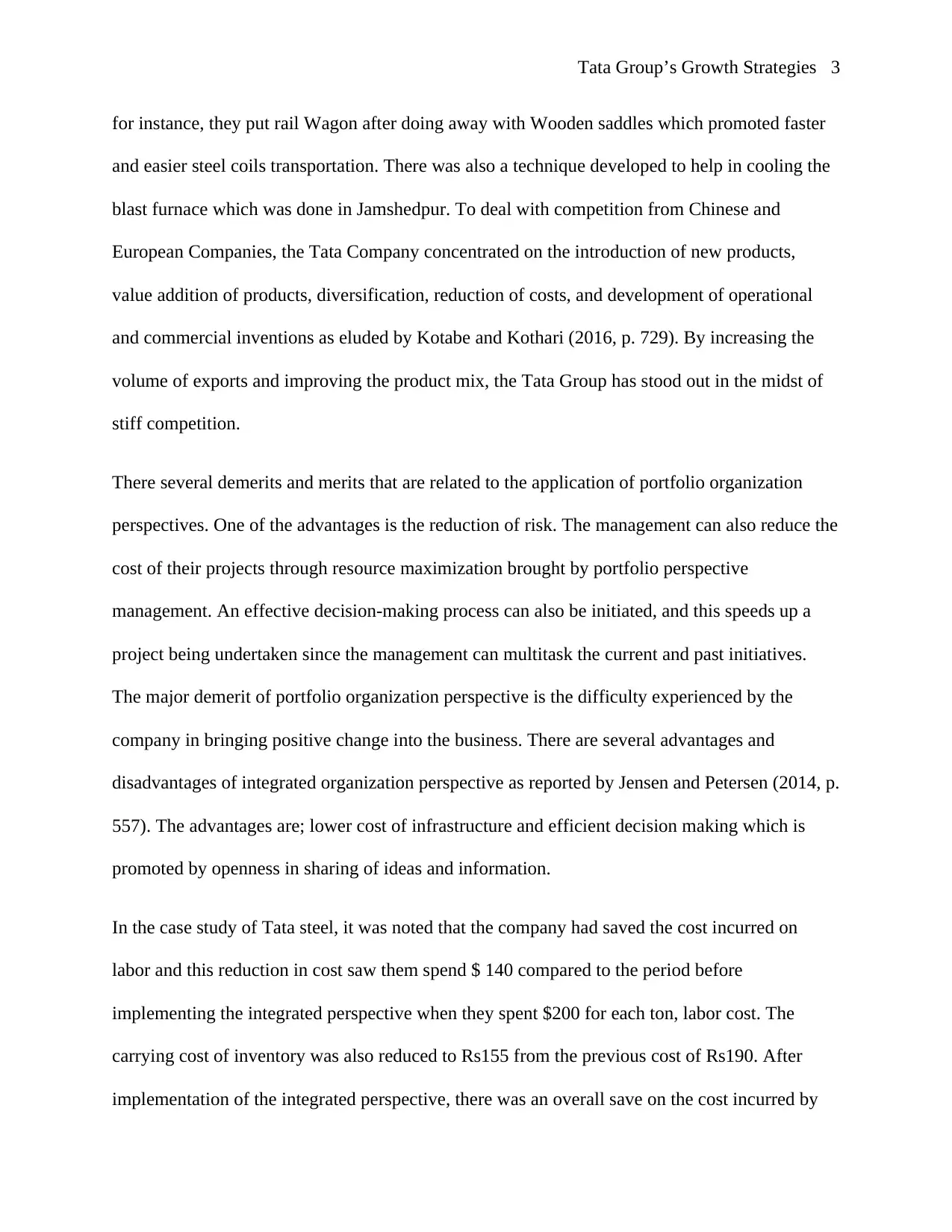
Tata Group’s Growth Strategies 3
for instance, they put rail Wagon after doing away with Wooden saddles which promoted faster
and easier steel coils transportation. There was also a technique developed to help in cooling the
blast furnace which was done in Jamshedpur. To deal with competition from Chinese and
European Companies, the Tata Company concentrated on the introduction of new products,
value addition of products, diversification, reduction of costs, and development of operational
and commercial inventions as eluded by Kotabe and Kothari (2016, p. 729). By increasing the
volume of exports and improving the product mix, the Tata Group has stood out in the midst of
stiff competition.
There several demerits and merits that are related to the application of portfolio organization
perspectives. One of the advantages is the reduction of risk. The management can also reduce the
cost of their projects through resource maximization brought by portfolio perspective
management. An effective decision-making process can also be initiated, and this speeds up a
project being undertaken since the management can multitask the current and past initiatives.
The major demerit of portfolio organization perspective is the difficulty experienced by the
company in bringing positive change into the business. There are several advantages and
disadvantages of integrated organization perspective as reported by Jensen and Petersen (2014, p.
557). The advantages are; lower cost of infrastructure and efficient decision making which is
promoted by openness in sharing of ideas and information.
In the case study of Tata steel, it was noted that the company had saved the cost incurred on
labor and this reduction in cost saw them spend $ 140 compared to the period before
implementing the integrated perspective when they spent $200 for each ton, labor cost. The
carrying cost of inventory was also reduced to Rs155 from the previous cost of Rs190. After
implementation of the integrated perspective, there was an overall save on the cost incurred by
for instance, they put rail Wagon after doing away with Wooden saddles which promoted faster
and easier steel coils transportation. There was also a technique developed to help in cooling the
blast furnace which was done in Jamshedpur. To deal with competition from Chinese and
European Companies, the Tata Company concentrated on the introduction of new products,
value addition of products, diversification, reduction of costs, and development of operational
and commercial inventions as eluded by Kotabe and Kothari (2016, p. 729). By increasing the
volume of exports and improving the product mix, the Tata Group has stood out in the midst of
stiff competition.
There several demerits and merits that are related to the application of portfolio organization
perspectives. One of the advantages is the reduction of risk. The management can also reduce the
cost of their projects through resource maximization brought by portfolio perspective
management. An effective decision-making process can also be initiated, and this speeds up a
project being undertaken since the management can multitask the current and past initiatives.
The major demerit of portfolio organization perspective is the difficulty experienced by the
company in bringing positive change into the business. There are several advantages and
disadvantages of integrated organization perspective as reported by Jensen and Petersen (2014, p.
557). The advantages are; lower cost of infrastructure and efficient decision making which is
promoted by openness in sharing of ideas and information.
In the case study of Tata steel, it was noted that the company had saved the cost incurred on
labor and this reduction in cost saw them spend $ 140 compared to the period before
implementing the integrated perspective when they spent $200 for each ton, labor cost. The
carrying cost of inventory was also reduced to Rs155 from the previous cost of Rs190. After
implementation of the integrated perspective, there was an overall save on the cost incurred by
⊘ This is a preview!⊘
Do you want full access?
Subscribe today to unlock all pages.

Trusted by 1+ million students worldwide
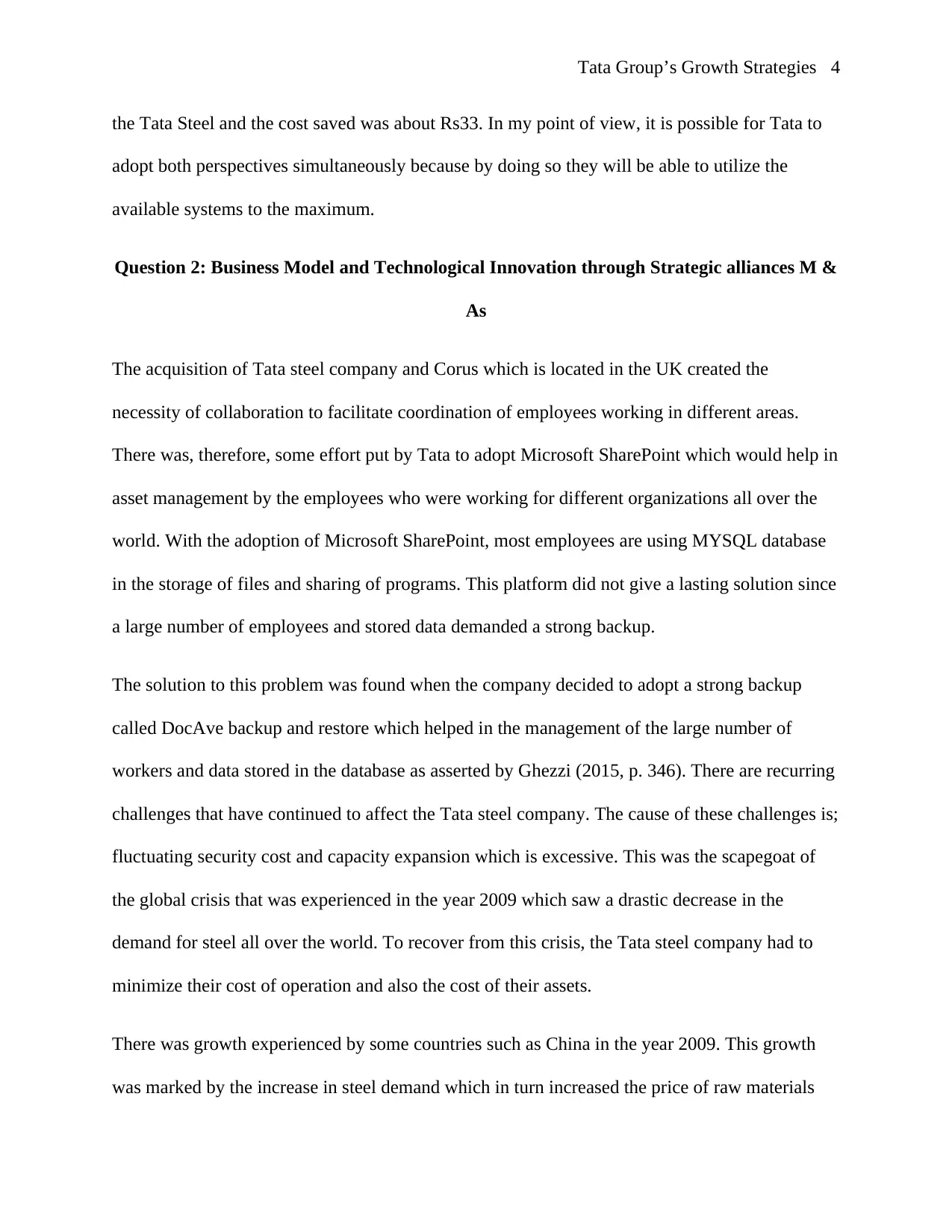
Tata Group’s Growth Strategies 4
the Tata Steel and the cost saved was about Rs33. In my point of view, it is possible for Tata to
adopt both perspectives simultaneously because by doing so they will be able to utilize the
available systems to the maximum.
Question 2: Business Model and Technological Innovation through Strategic alliances M &
As
The acquisition of Tata steel company and Corus which is located in the UK created the
necessity of collaboration to facilitate coordination of employees working in different areas.
There was, therefore, some effort put by Tata to adopt Microsoft SharePoint which would help in
asset management by the employees who were working for different organizations all over the
world. With the adoption of Microsoft SharePoint, most employees are using MYSQL database
in the storage of files and sharing of programs. This platform did not give a lasting solution since
a large number of employees and stored data demanded a strong backup.
The solution to this problem was found when the company decided to adopt a strong backup
called DocAve backup and restore which helped in the management of the large number of
workers and data stored in the database as asserted by Ghezzi (2015, p. 346). There are recurring
challenges that have continued to affect the Tata steel company. The cause of these challenges is;
fluctuating security cost and capacity expansion which is excessive. This was the scapegoat of
the global crisis that was experienced in the year 2009 which saw a drastic decrease in the
demand for steel all over the world. To recover from this crisis, the Tata steel company had to
minimize their cost of operation and also the cost of their assets.
There was growth experienced by some countries such as China in the year 2009. This growth
was marked by the increase in steel demand which in turn increased the price of raw materials
the Tata Steel and the cost saved was about Rs33. In my point of view, it is possible for Tata to
adopt both perspectives simultaneously because by doing so they will be able to utilize the
available systems to the maximum.
Question 2: Business Model and Technological Innovation through Strategic alliances M &
As
The acquisition of Tata steel company and Corus which is located in the UK created the
necessity of collaboration to facilitate coordination of employees working in different areas.
There was, therefore, some effort put by Tata to adopt Microsoft SharePoint which would help in
asset management by the employees who were working for different organizations all over the
world. With the adoption of Microsoft SharePoint, most employees are using MYSQL database
in the storage of files and sharing of programs. This platform did not give a lasting solution since
a large number of employees and stored data demanded a strong backup.
The solution to this problem was found when the company decided to adopt a strong backup
called DocAve backup and restore which helped in the management of the large number of
workers and data stored in the database as asserted by Ghezzi (2015, p. 346). There are recurring
challenges that have continued to affect the Tata steel company. The cause of these challenges is;
fluctuating security cost and capacity expansion which is excessive. This was the scapegoat of
the global crisis that was experienced in the year 2009 which saw a drastic decrease in the
demand for steel all over the world. To recover from this crisis, the Tata steel company had to
minimize their cost of operation and also the cost of their assets.
There was growth experienced by some countries such as China in the year 2009. This growth
was marked by the increase in steel demand which in turn increased the price of raw materials
Paraphrase This Document
Need a fresh take? Get an instant paraphrase of this document with our AI Paraphraser
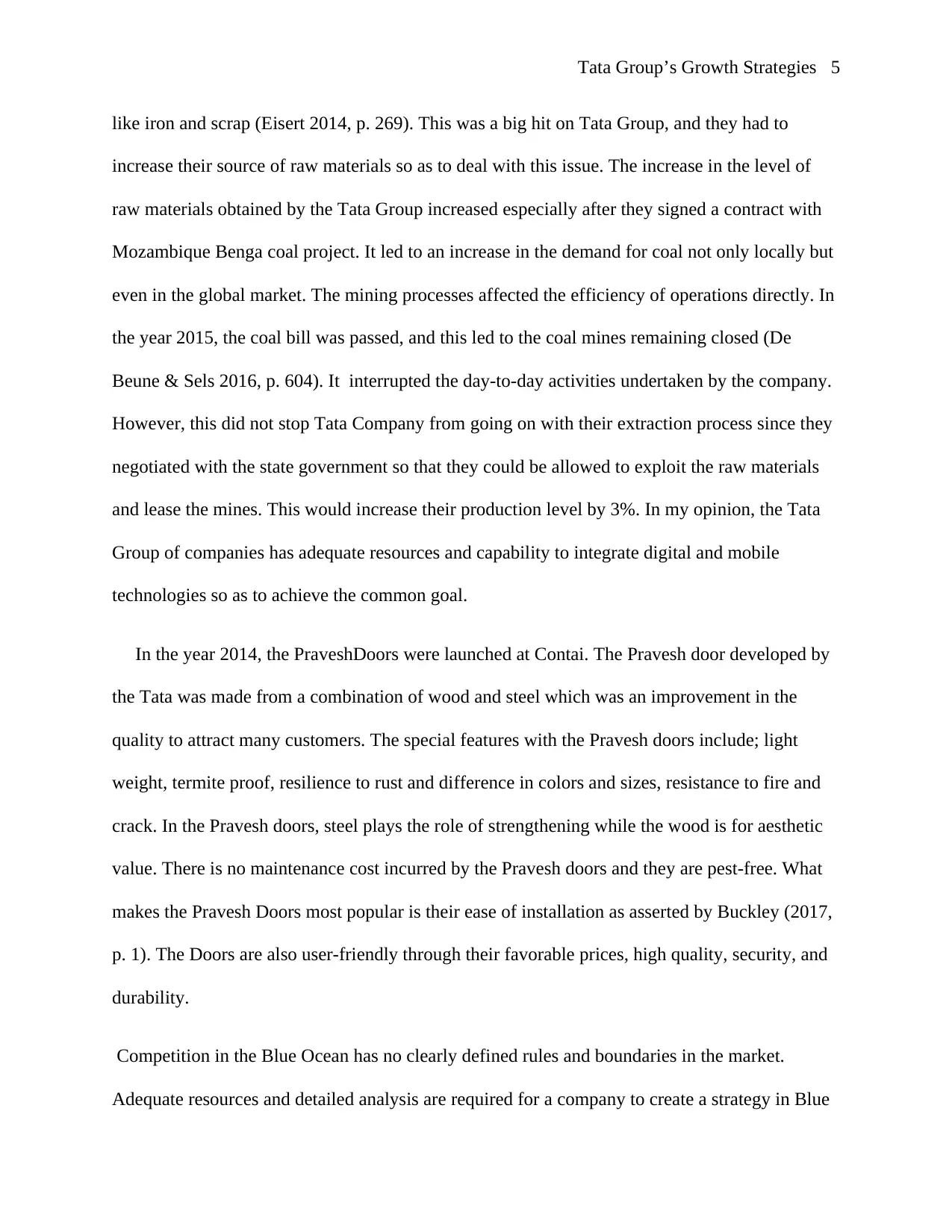
Tata Group’s Growth Strategies 5
like iron and scrap (Eisert 2014, p. 269). This was a big hit on Tata Group, and they had to
increase their source of raw materials so as to deal with this issue. The increase in the level of
raw materials obtained by the Tata Group increased especially after they signed a contract with
Mozambique Benga coal project. It led to an increase in the demand for coal not only locally but
even in the global market. The mining processes affected the efficiency of operations directly. In
the year 2015, the coal bill was passed, and this led to the coal mines remaining closed (De
Beune & Sels 2016, p. 604). It interrupted the day-to-day activities undertaken by the company.
However, this did not stop Tata Company from going on with their extraction process since they
negotiated with the state government so that they could be allowed to exploit the raw materials
and lease the mines. This would increase their production level by 3%. In my opinion, the Tata
Group of companies has adequate resources and capability to integrate digital and mobile
technologies so as to achieve the common goal.
In the year 2014, the PraveshDoors were launched at Contai. The Pravesh door developed by
the Tata was made from a combination of wood and steel which was an improvement in the
quality to attract many customers. The special features with the Pravesh doors include; light
weight, termite proof, resilience to rust and difference in colors and sizes, resistance to fire and
crack. In the Pravesh doors, steel plays the role of strengthening while the wood is for aesthetic
value. There is no maintenance cost incurred by the Pravesh doors and they are pest-free. What
makes the Pravesh Doors most popular is their ease of installation as asserted by Buckley (2017,
p. 1). The Doors are also user-friendly through their favorable prices, high quality, security, and
durability.
Competition in the Blue Ocean has no clearly defined rules and boundaries in the market.
Adequate resources and detailed analysis are required for a company to create a strategy in Blue
like iron and scrap (Eisert 2014, p. 269). This was a big hit on Tata Group, and they had to
increase their source of raw materials so as to deal with this issue. The increase in the level of
raw materials obtained by the Tata Group increased especially after they signed a contract with
Mozambique Benga coal project. It led to an increase in the demand for coal not only locally but
even in the global market. The mining processes affected the efficiency of operations directly. In
the year 2015, the coal bill was passed, and this led to the coal mines remaining closed (De
Beune & Sels 2016, p. 604). It interrupted the day-to-day activities undertaken by the company.
However, this did not stop Tata Company from going on with their extraction process since they
negotiated with the state government so that they could be allowed to exploit the raw materials
and lease the mines. This would increase their production level by 3%. In my opinion, the Tata
Group of companies has adequate resources and capability to integrate digital and mobile
technologies so as to achieve the common goal.
In the year 2014, the PraveshDoors were launched at Contai. The Pravesh door developed by
the Tata was made from a combination of wood and steel which was an improvement in the
quality to attract many customers. The special features with the Pravesh doors include; light
weight, termite proof, resilience to rust and difference in colors and sizes, resistance to fire and
crack. In the Pravesh doors, steel plays the role of strengthening while the wood is for aesthetic
value. There is no maintenance cost incurred by the Pravesh doors and they are pest-free. What
makes the Pravesh Doors most popular is their ease of installation as asserted by Buckley (2017,
p. 1). The Doors are also user-friendly through their favorable prices, high quality, security, and
durability.
Competition in the Blue Ocean has no clearly defined rules and boundaries in the market.
Adequate resources and detailed analysis are required for a company to create a strategy in Blue
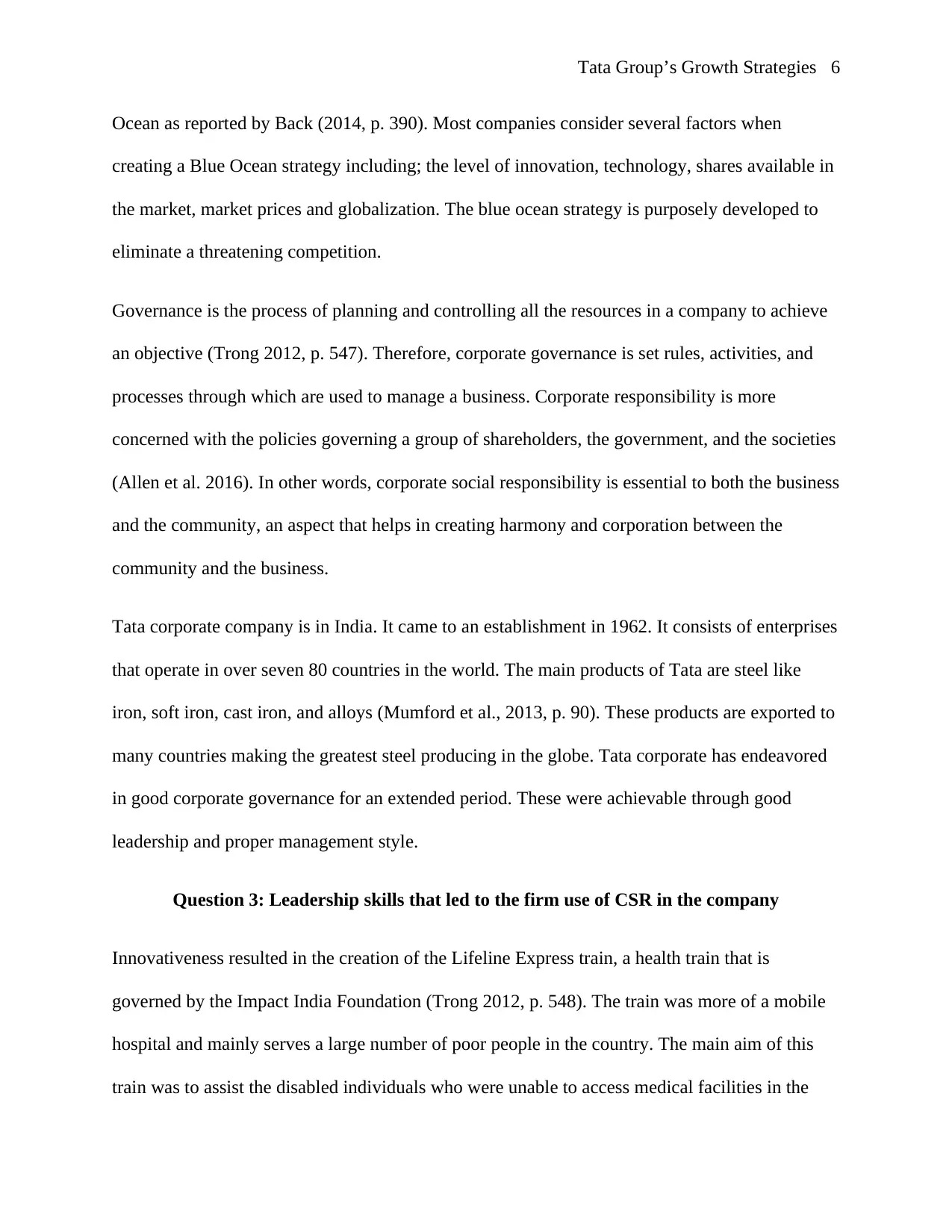
Tata Group’s Growth Strategies 6
Ocean as reported by Back (2014, p. 390). Most companies consider several factors when
creating a Blue Ocean strategy including; the level of innovation, technology, shares available in
the market, market prices and globalization. The blue ocean strategy is purposely developed to
eliminate a threatening competition.
Governance is the process of planning and controlling all the resources in a company to achieve
an objective (Trong 2012, p. 547). Therefore, corporate governance is set rules, activities, and
processes through which are used to manage a business. Corporate responsibility is more
concerned with the policies governing a group of shareholders, the government, and the societies
(Allen et al. 2016). In other words, corporate social responsibility is essential to both the business
and the community, an aspect that helps in creating harmony and corporation between the
community and the business.
Tata corporate company is in India. It came to an establishment in 1962. It consists of enterprises
that operate in over seven 80 countries in the world. The main products of Tata are steel like
iron, soft iron, cast iron, and alloys (Mumford et al., 2013, p. 90). These products are exported to
many countries making the greatest steel producing in the globe. Tata corporate has endeavored
in good corporate governance for an extended period. These were achievable through good
leadership and proper management style.
Question 3: Leadership skills that led to the firm use of CSR in the company
Innovativeness resulted in the creation of the Lifeline Express train, a health train that is
governed by the Impact India Foundation (Trong 2012, p. 548). The train was more of a mobile
hospital and mainly serves a large number of poor people in the country. The main aim of this
train was to assist the disabled individuals who were unable to access medical facilities in the
Ocean as reported by Back (2014, p. 390). Most companies consider several factors when
creating a Blue Ocean strategy including; the level of innovation, technology, shares available in
the market, market prices and globalization. The blue ocean strategy is purposely developed to
eliminate a threatening competition.
Governance is the process of planning and controlling all the resources in a company to achieve
an objective (Trong 2012, p. 547). Therefore, corporate governance is set rules, activities, and
processes through which are used to manage a business. Corporate responsibility is more
concerned with the policies governing a group of shareholders, the government, and the societies
(Allen et al. 2016). In other words, corporate social responsibility is essential to both the business
and the community, an aspect that helps in creating harmony and corporation between the
community and the business.
Tata corporate company is in India. It came to an establishment in 1962. It consists of enterprises
that operate in over seven 80 countries in the world. The main products of Tata are steel like
iron, soft iron, cast iron, and alloys (Mumford et al., 2013, p. 90). These products are exported to
many countries making the greatest steel producing in the globe. Tata corporate has endeavored
in good corporate governance for an extended period. These were achievable through good
leadership and proper management style.
Question 3: Leadership skills that led to the firm use of CSR in the company
Innovativeness resulted in the creation of the Lifeline Express train, a health train that is
governed by the Impact India Foundation (Trong 2012, p. 548). The train was more of a mobile
hospital and mainly serves a large number of poor people in the country. The main aim of this
train was to assist the disabled individuals who were unable to access medical facilities in the
⊘ This is a preview!⊘
Do you want full access?
Subscribe today to unlock all pages.

Trusted by 1+ million students worldwide
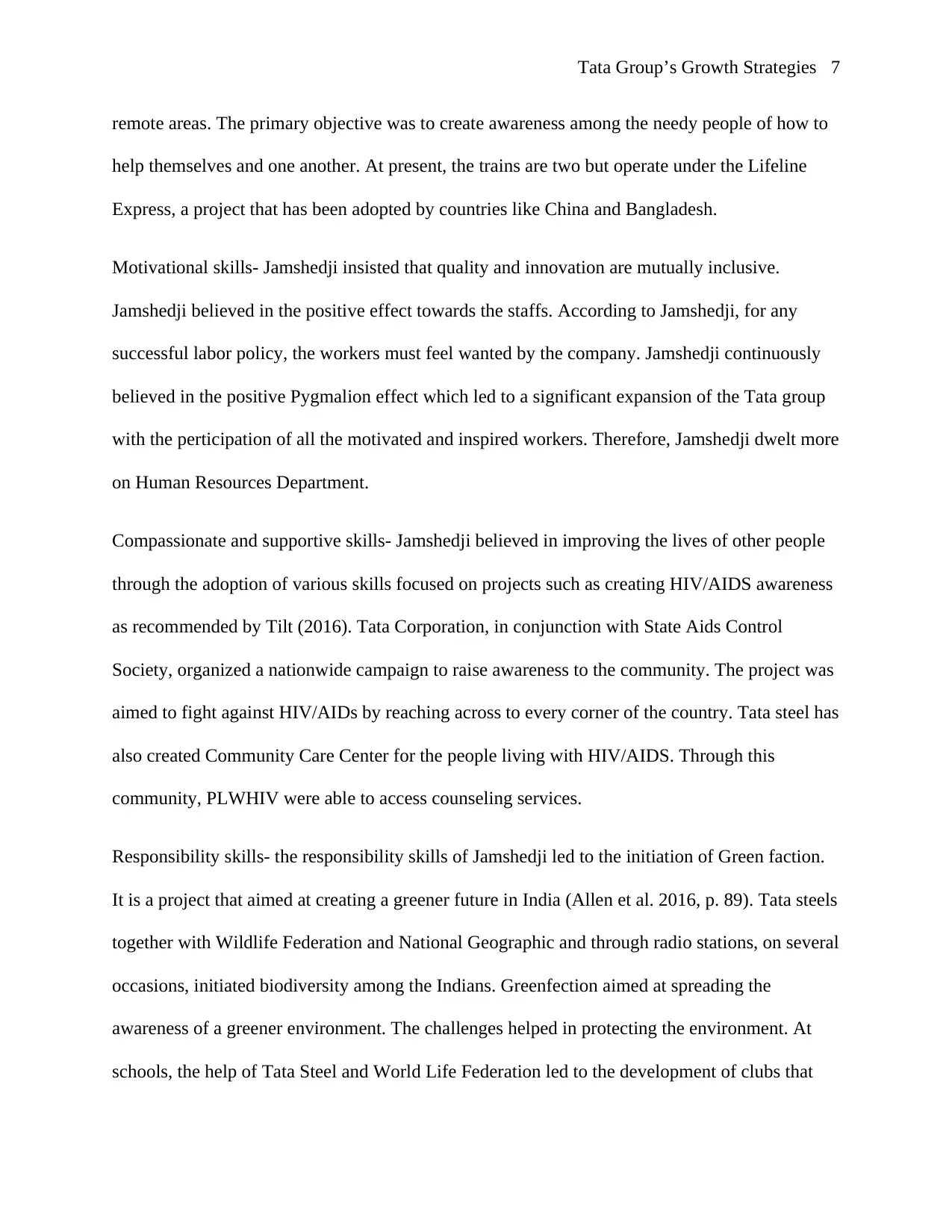
Tata Group’s Growth Strategies 7
remote areas. The primary objective was to create awareness among the needy people of how to
help themselves and one another. At present, the trains are two but operate under the Lifeline
Express, a project that has been adopted by countries like China and Bangladesh.
Motivational skills- Jamshedji insisted that quality and innovation are mutually inclusive.
Jamshedji believed in the positive effect towards the staffs. According to Jamshedji, for any
successful labor policy, the workers must feel wanted by the company. Jamshedji continuously
believed in the positive Pygmalion effect which led to a significant expansion of the Tata group
with the perticipation of all the motivated and inspired workers. Therefore, Jamshedji dwelt more
on Human Resources Department.
Compassionate and supportive skills- Jamshedji believed in improving the lives of other people
through the adoption of various skills focused on projects such as creating HIV/AIDS awareness
as recommended by Tilt (2016). Tata Corporation, in conjunction with State Aids Control
Society, organized a nationwide campaign to raise awareness to the community. The project was
aimed to fight against HIV/AIDs by reaching across to every corner of the country. Tata steel has
also created Community Care Center for the people living with HIV/AIDS. Through this
community, PLWHIV were able to access counseling services.
Responsibility skills- the responsibility skills of Jamshedji led to the initiation of Green faction.
It is a project that aimed at creating a greener future in India (Allen et al. 2016, p. 89). Tata steels
together with Wildlife Federation and National Geographic and through radio stations, on several
occasions, initiated biodiversity among the Indians. Greenfection aimed at spreading the
awareness of a greener environment. The challenges helped in protecting the environment. At
schools, the help of Tata Steel and World Life Federation led to the development of clubs that
remote areas. The primary objective was to create awareness among the needy people of how to
help themselves and one another. At present, the trains are two but operate under the Lifeline
Express, a project that has been adopted by countries like China and Bangladesh.
Motivational skills- Jamshedji insisted that quality and innovation are mutually inclusive.
Jamshedji believed in the positive effect towards the staffs. According to Jamshedji, for any
successful labor policy, the workers must feel wanted by the company. Jamshedji continuously
believed in the positive Pygmalion effect which led to a significant expansion of the Tata group
with the perticipation of all the motivated and inspired workers. Therefore, Jamshedji dwelt more
on Human Resources Department.
Compassionate and supportive skills- Jamshedji believed in improving the lives of other people
through the adoption of various skills focused on projects such as creating HIV/AIDS awareness
as recommended by Tilt (2016). Tata Corporation, in conjunction with State Aids Control
Society, organized a nationwide campaign to raise awareness to the community. The project was
aimed to fight against HIV/AIDs by reaching across to every corner of the country. Tata steel has
also created Community Care Center for the people living with HIV/AIDS. Through this
community, PLWHIV were able to access counseling services.
Responsibility skills- the responsibility skills of Jamshedji led to the initiation of Green faction.
It is a project that aimed at creating a greener future in India (Allen et al. 2016, p. 89). Tata steels
together with Wildlife Federation and National Geographic and through radio stations, on several
occasions, initiated biodiversity among the Indians. Greenfection aimed at spreading the
awareness of a greener environment. The challenges helped in protecting the environment. At
schools, the help of Tata Steel and World Life Federation led to the development of clubs that
Paraphrase This Document
Need a fresh take? Get an instant paraphrase of this document with our AI Paraphraser
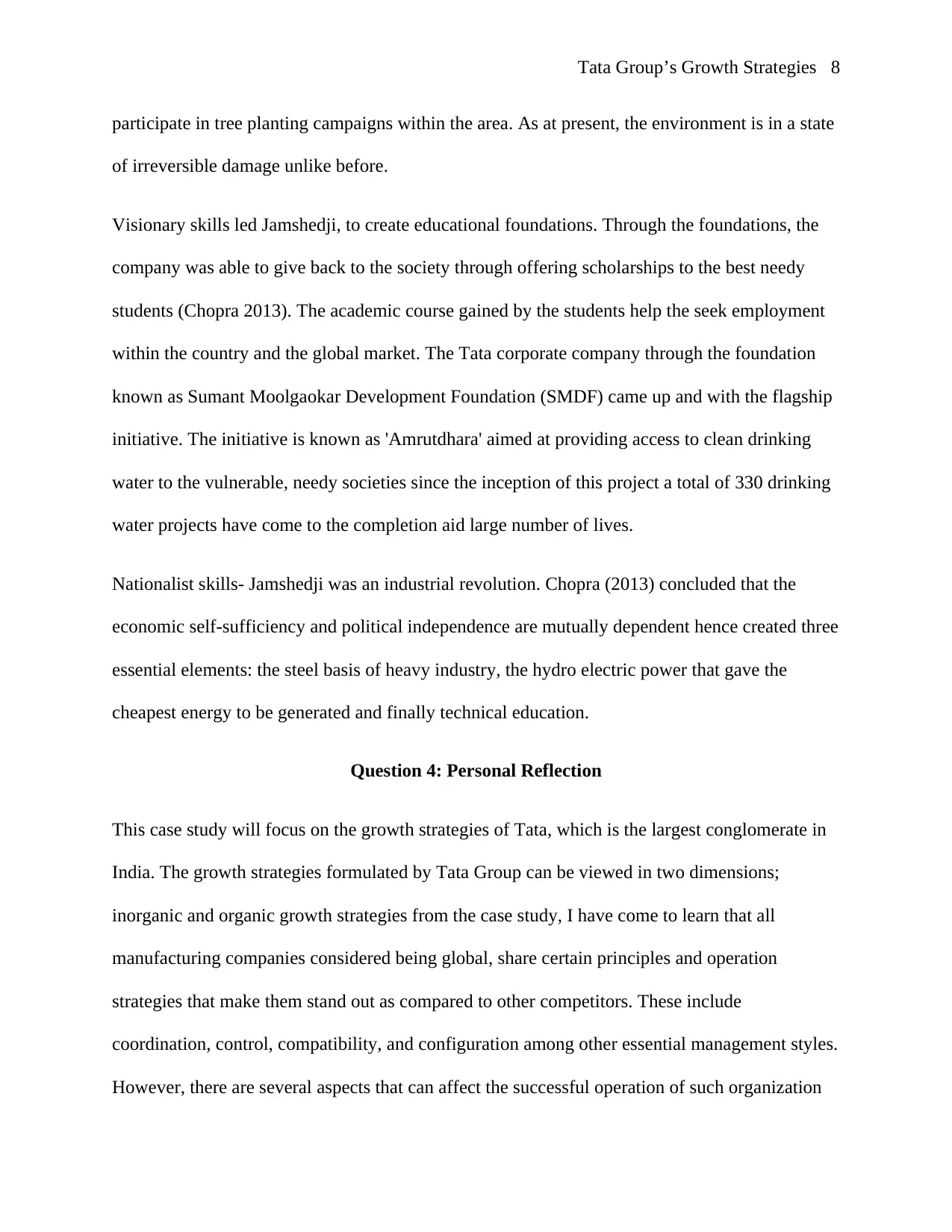
Tata Group’s Growth Strategies 8
participate in tree planting campaigns within the area. As at present, the environment is in a state
of irreversible damage unlike before.
Visionary skills led Jamshedji, to create educational foundations. Through the foundations, the
company was able to give back to the society through offering scholarships to the best needy
students (Chopra 2013). The academic course gained by the students help the seek employment
within the country and the global market. The Tata corporate company through the foundation
known as Sumant Moolgaokar Development Foundation (SMDF) came up and with the flagship
initiative. The initiative is known as 'Amrutdhara' aimed at providing access to clean drinking
water to the vulnerable, needy societies since the inception of this project a total of 330 drinking
water projects have come to the completion aid large number of lives.
Nationalist skills- Jamshedji was an industrial revolution. Chopra (2013) concluded that the
economic self-sufficiency and political independence are mutually dependent hence created three
essential elements: the steel basis of heavy industry, the hydro electric power that gave the
cheapest energy to be generated and finally technical education.
Question 4: Personal Reflection
This case study will focus on the growth strategies of Tata, which is the largest conglomerate in
India. The growth strategies formulated by Tata Group can be viewed in two dimensions;
inorganic and organic growth strategies from the case study, I have come to learn that all
manufacturing companies considered being global, share certain principles and operation
strategies that make them stand out as compared to other competitors. These include
coordination, control, compatibility, and configuration among other essential management styles.
However, there are several aspects that can affect the successful operation of such organization
participate in tree planting campaigns within the area. As at present, the environment is in a state
of irreversible damage unlike before.
Visionary skills led Jamshedji, to create educational foundations. Through the foundations, the
company was able to give back to the society through offering scholarships to the best needy
students (Chopra 2013). The academic course gained by the students help the seek employment
within the country and the global market. The Tata corporate company through the foundation
known as Sumant Moolgaokar Development Foundation (SMDF) came up and with the flagship
initiative. The initiative is known as 'Amrutdhara' aimed at providing access to clean drinking
water to the vulnerable, needy societies since the inception of this project a total of 330 drinking
water projects have come to the completion aid large number of lives.
Nationalist skills- Jamshedji was an industrial revolution. Chopra (2013) concluded that the
economic self-sufficiency and political independence are mutually dependent hence created three
essential elements: the steel basis of heavy industry, the hydro electric power that gave the
cheapest energy to be generated and finally technical education.
Question 4: Personal Reflection
This case study will focus on the growth strategies of Tata, which is the largest conglomerate in
India. The growth strategies formulated by Tata Group can be viewed in two dimensions;
inorganic and organic growth strategies from the case study, I have come to learn that all
manufacturing companies considered being global, share certain principles and operation
strategies that make them stand out as compared to other competitors. These include
coordination, control, compatibility, and configuration among other essential management styles.
However, there are several aspects that can affect the successful operation of such organization
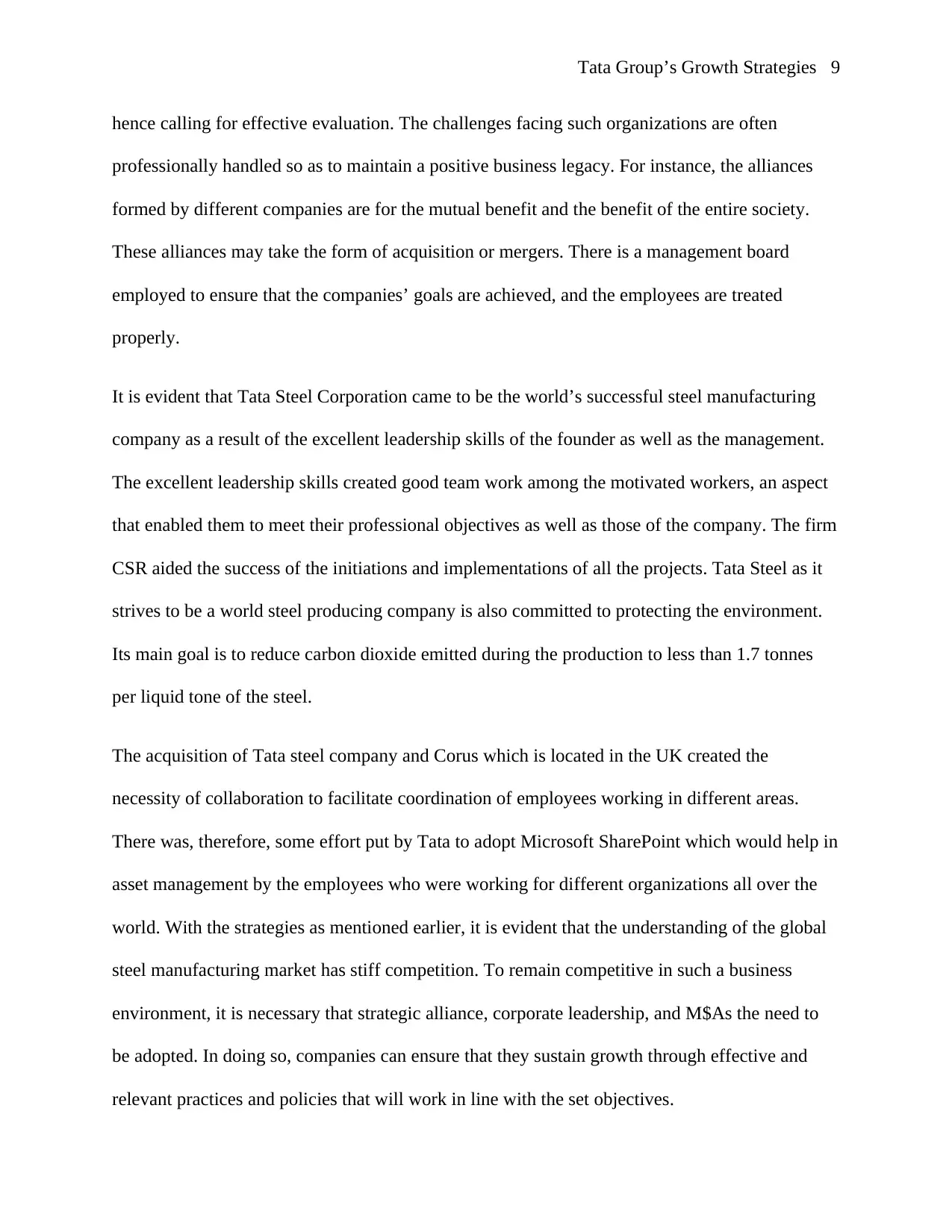
Tata Group’s Growth Strategies 9
hence calling for effective evaluation. The challenges facing such organizations are often
professionally handled so as to maintain a positive business legacy. For instance, the alliances
formed by different companies are for the mutual benefit and the benefit of the entire society.
These alliances may take the form of acquisition or mergers. There is a management board
employed to ensure that the companies’ goals are achieved, and the employees are treated
properly.
It is evident that Tata Steel Corporation came to be the world’s successful steel manufacturing
company as a result of the excellent leadership skills of the founder as well as the management.
The excellent leadership skills created good team work among the motivated workers, an aspect
that enabled them to meet their professional objectives as well as those of the company. The firm
CSR aided the success of the initiations and implementations of all the projects. Tata Steel as it
strives to be a world steel producing company is also committed to protecting the environment.
Its main goal is to reduce carbon dioxide emitted during the production to less than 1.7 tonnes
per liquid tone of the steel.
The acquisition of Tata steel company and Corus which is located in the UK created the
necessity of collaboration to facilitate coordination of employees working in different areas.
There was, therefore, some effort put by Tata to adopt Microsoft SharePoint which would help in
asset management by the employees who were working for different organizations all over the
world. With the strategies as mentioned earlier, it is evident that the understanding of the global
steel manufacturing market has stiff competition. To remain competitive in such a business
environment, it is necessary that strategic alliance, corporate leadership, and M$As the need to
be adopted. In doing so, companies can ensure that they sustain growth through effective and
relevant practices and policies that will work in line with the set objectives.
hence calling for effective evaluation. The challenges facing such organizations are often
professionally handled so as to maintain a positive business legacy. For instance, the alliances
formed by different companies are for the mutual benefit and the benefit of the entire society.
These alliances may take the form of acquisition or mergers. There is a management board
employed to ensure that the companies’ goals are achieved, and the employees are treated
properly.
It is evident that Tata Steel Corporation came to be the world’s successful steel manufacturing
company as a result of the excellent leadership skills of the founder as well as the management.
The excellent leadership skills created good team work among the motivated workers, an aspect
that enabled them to meet their professional objectives as well as those of the company. The firm
CSR aided the success of the initiations and implementations of all the projects. Tata Steel as it
strives to be a world steel producing company is also committed to protecting the environment.
Its main goal is to reduce carbon dioxide emitted during the production to less than 1.7 tonnes
per liquid tone of the steel.
The acquisition of Tata steel company and Corus which is located in the UK created the
necessity of collaboration to facilitate coordination of employees working in different areas.
There was, therefore, some effort put by Tata to adopt Microsoft SharePoint which would help in
asset management by the employees who were working for different organizations all over the
world. With the strategies as mentioned earlier, it is evident that the understanding of the global
steel manufacturing market has stiff competition. To remain competitive in such a business
environment, it is necessary that strategic alliance, corporate leadership, and M$As the need to
be adopted. In doing so, companies can ensure that they sustain growth through effective and
relevant practices and policies that will work in line with the set objectives.
⊘ This is a preview!⊘
Do you want full access?
Subscribe today to unlock all pages.

Trusted by 1+ million students worldwide
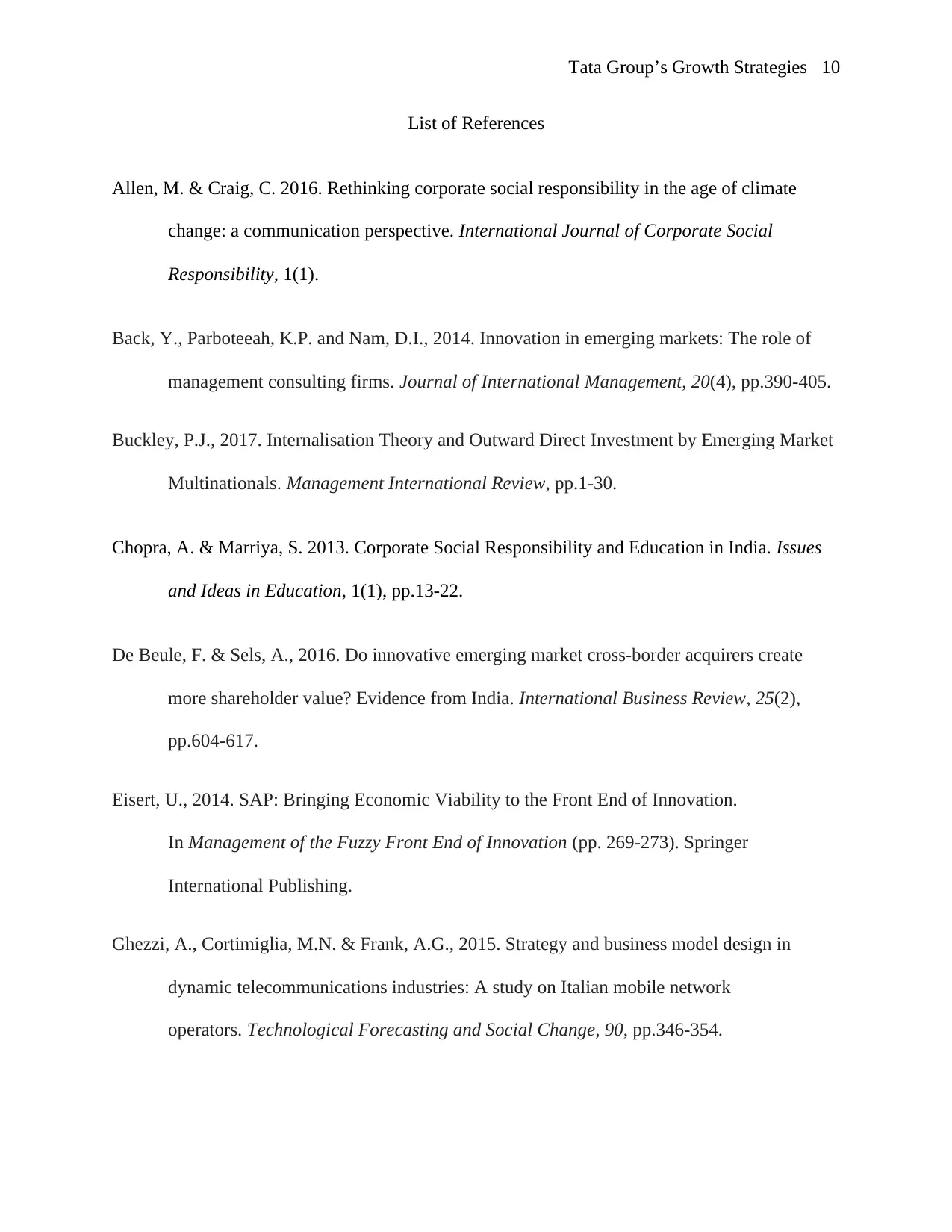
Tata Group’s Growth Strategies 10
List of References
Allen, M. & Craig, C. 2016. Rethinking corporate social responsibility in the age of climate
change: a communication perspective. International Journal of Corporate Social
Responsibility, 1(1).
Back, Y., Parboteeah, K.P. and Nam, D.I., 2014. Innovation in emerging markets: The role of
management consulting firms. Journal of International Management, 20(4), pp.390-405.
Buckley, P.J., 2017. Internalisation Theory and Outward Direct Investment by Emerging Market
Multinationals. Management International Review, pp.1-30.
Chopra, A. & Marriya, S. 2013. Corporate Social Responsibility and Education in India. Issues
and Ideas in Education, 1(1), pp.13-22.
De Beule, F. & Sels, A., 2016. Do innovative emerging market cross-border acquirers create
more shareholder value? Evidence from India. International Business Review, 25(2),
pp.604-617.
Eisert, U., 2014. SAP: Bringing Economic Viability to the Front End of Innovation.
In Management of the Fuzzy Front End of Innovation (pp. 269-273). Springer
International Publishing.
Ghezzi, A., Cortimiglia, M.N. & Frank, A.G., 2015. Strategy and business model design in
dynamic telecommunications industries: A study on Italian mobile network
operators. Technological Forecasting and Social Change, 90, pp.346-354.
List of References
Allen, M. & Craig, C. 2016. Rethinking corporate social responsibility in the age of climate
change: a communication perspective. International Journal of Corporate Social
Responsibility, 1(1).
Back, Y., Parboteeah, K.P. and Nam, D.I., 2014. Innovation in emerging markets: The role of
management consulting firms. Journal of International Management, 20(4), pp.390-405.
Buckley, P.J., 2017. Internalisation Theory and Outward Direct Investment by Emerging Market
Multinationals. Management International Review, pp.1-30.
Chopra, A. & Marriya, S. 2013. Corporate Social Responsibility and Education in India. Issues
and Ideas in Education, 1(1), pp.13-22.
De Beule, F. & Sels, A., 2016. Do innovative emerging market cross-border acquirers create
more shareholder value? Evidence from India. International Business Review, 25(2),
pp.604-617.
Eisert, U., 2014. SAP: Bringing Economic Viability to the Front End of Innovation.
In Management of the Fuzzy Front End of Innovation (pp. 269-273). Springer
International Publishing.
Ghezzi, A., Cortimiglia, M.N. & Frank, A.G., 2015. Strategy and business model design in
dynamic telecommunications industries: A study on Italian mobile network
operators. Technological Forecasting and Social Change, 90, pp.346-354.
Paraphrase This Document
Need a fresh take? Get an instant paraphrase of this document with our AI Paraphraser
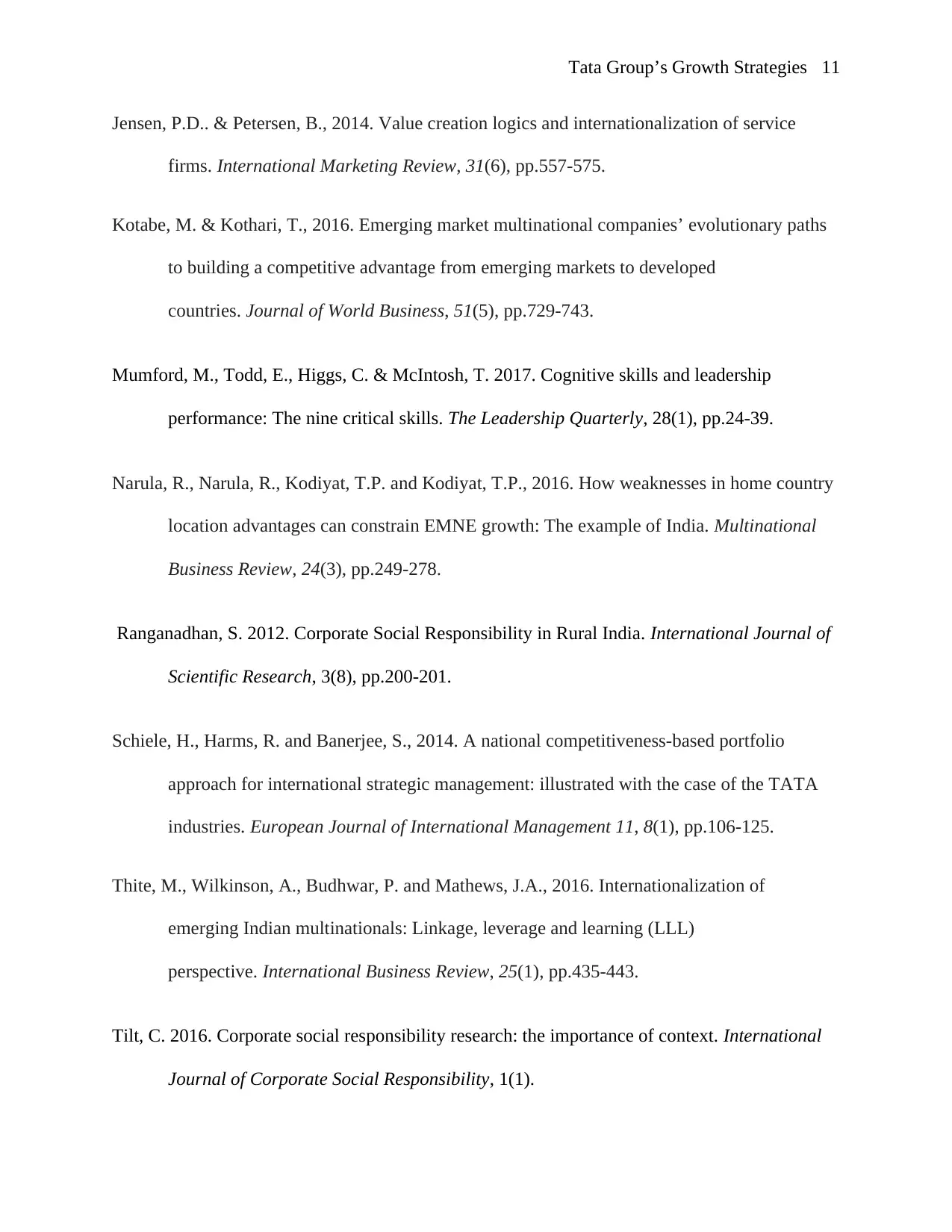
Tata Group’s Growth Strategies 11
Jensen, P.D.. & Petersen, B., 2014. Value creation logics and internationalization of service
firms. International Marketing Review, 31(6), pp.557-575.
Kotabe, M. & Kothari, T., 2016. Emerging market multinational companies’ evolutionary paths
to building a competitive advantage from emerging markets to developed
countries. Journal of World Business, 51(5), pp.729-743.
Mumford, M., Todd, E., Higgs, C. & McIntosh, T. 2017. Cognitive skills and leadership
performance: The nine critical skills. The Leadership Quarterly, 28(1), pp.24-39.
Narula, R., Narula, R., Kodiyat, T.P. and Kodiyat, T.P., 2016. How weaknesses in home country
location advantages can constrain EMNE growth: The example of India. Multinational
Business Review, 24(3), pp.249-278.
Ranganadhan, S. 2012. Corporate Social Responsibility in Rural India. International Journal of
Scientific Research, 3(8), pp.200-201.
Schiele, H., Harms, R. and Banerjee, S., 2014. A national competitiveness-based portfolio
approach for international strategic management: illustrated with the case of the TATA
industries. European Journal of International Management 11, 8(1), pp.106-125.
Thite, M., Wilkinson, A., Budhwar, P. and Mathews, J.A., 2016. Internationalization of
emerging Indian multinationals: Linkage, leverage and learning (LLL)
perspective. International Business Review, 25(1), pp.435-443.
Tilt, C. 2016. Corporate social responsibility research: the importance of context. International
Journal of Corporate Social Responsibility, 1(1).
Jensen, P.D.. & Petersen, B., 2014. Value creation logics and internationalization of service
firms. International Marketing Review, 31(6), pp.557-575.
Kotabe, M. & Kothari, T., 2016. Emerging market multinational companies’ evolutionary paths
to building a competitive advantage from emerging markets to developed
countries. Journal of World Business, 51(5), pp.729-743.
Mumford, M., Todd, E., Higgs, C. & McIntosh, T. 2017. Cognitive skills and leadership
performance: The nine critical skills. The Leadership Quarterly, 28(1), pp.24-39.
Narula, R., Narula, R., Kodiyat, T.P. and Kodiyat, T.P., 2016. How weaknesses in home country
location advantages can constrain EMNE growth: The example of India. Multinational
Business Review, 24(3), pp.249-278.
Ranganadhan, S. 2012. Corporate Social Responsibility in Rural India. International Journal of
Scientific Research, 3(8), pp.200-201.
Schiele, H., Harms, R. and Banerjee, S., 2014. A national competitiveness-based portfolio
approach for international strategic management: illustrated with the case of the TATA
industries. European Journal of International Management 11, 8(1), pp.106-125.
Thite, M., Wilkinson, A., Budhwar, P. and Mathews, J.A., 2016. Internationalization of
emerging Indian multinationals: Linkage, leverage and learning (LLL)
perspective. International Business Review, 25(1), pp.435-443.
Tilt, C. 2016. Corporate social responsibility research: the importance of context. International
Journal of Corporate Social Responsibility, 1(1).
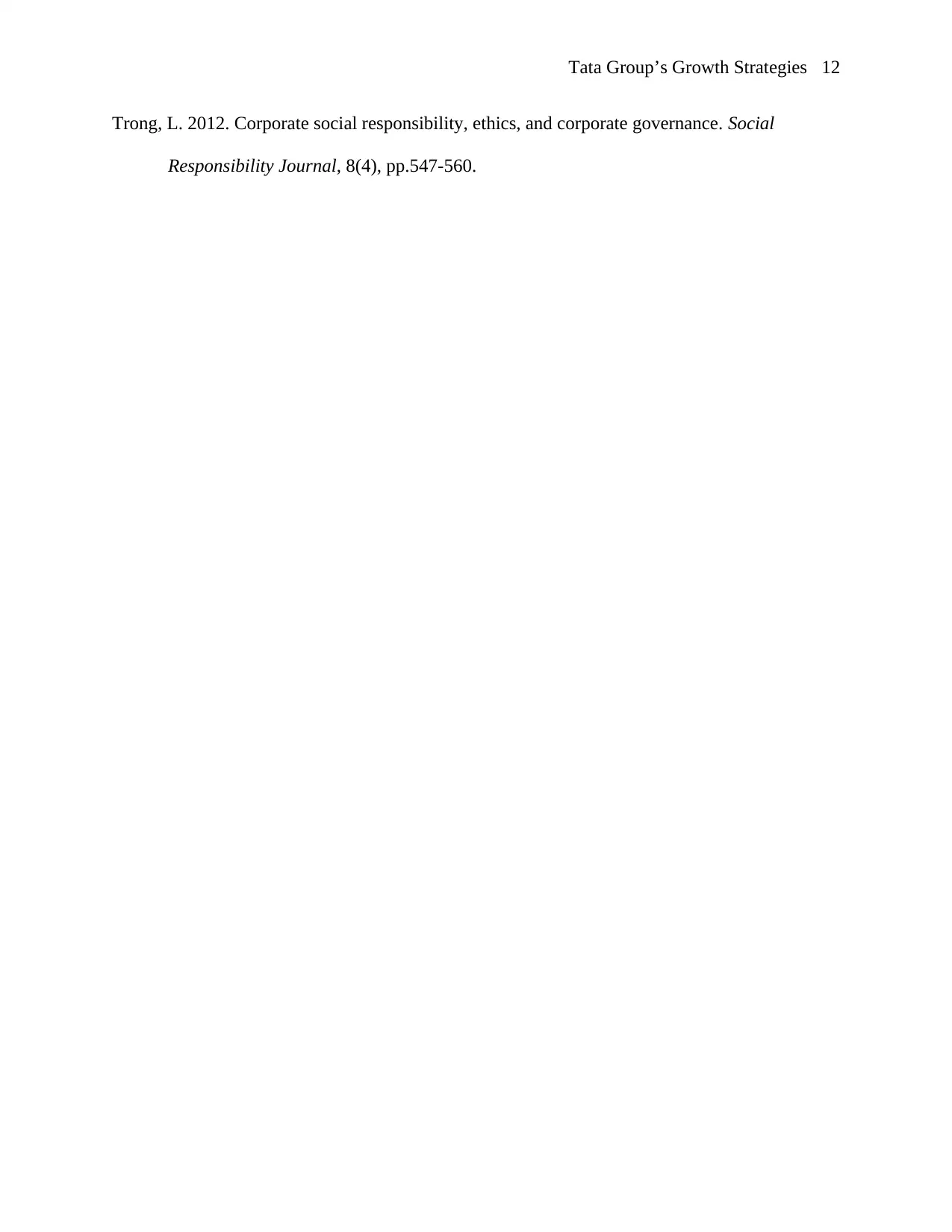
Tata Group’s Growth Strategies 12
Trong, L. 2012. Corporate social responsibility, ethics, and corporate governance. Social
Responsibility Journal, 8(4), pp.547-560.
Trong, L. 2012. Corporate social responsibility, ethics, and corporate governance. Social
Responsibility Journal, 8(4), pp.547-560.
⊘ This is a preview!⊘
Do you want full access?
Subscribe today to unlock all pages.

Trusted by 1+ million students worldwide
1 out of 13
Related Documents
Your All-in-One AI-Powered Toolkit for Academic Success.
+13062052269
info@desklib.com
Available 24*7 on WhatsApp / Email
![[object Object]](/_next/static/media/star-bottom.7253800d.svg)
Unlock your academic potential
Copyright © 2020–2025 A2Z Services. All Rights Reserved. Developed and managed by ZUCOL.




